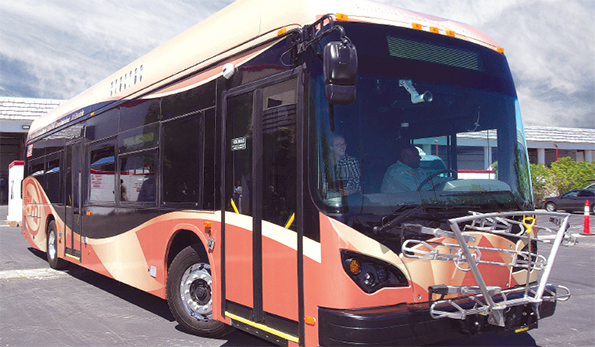
As AVTA’s new bus outperforms expectations, BYD turns its attention to disadvantaged businesses
BYD Motors, Lancaster, CA, one of China’s largest companies, is making waves in California – both with their battery-electric buses and community outreach.
—————————————————————————————————————————————
YOU MIGHT ALSO LIKE:
- Alex Clifford appointed as CEO/general manager of Santa Cruz Metro
- COTA plans for future
- Metro bus driver rescued Ohio residents from fire
—————————————————————————————————————————————
AVTA bus smashes expectations
The Antelope Valley Transit Authority’s (AVTA) new electric BYD bus is performing better than advertised. AVTA and BYD operators put the electric bus to the test this weekend during a 24-hour marathon ride that looped from Rosamond to Palmdale a total of 18 times.
AVTA, Lancaster, CA, provides local, commuter and dial-a-ride service to a population of more than 450,000 residents in the cities of Lancaster and Palmdale as well as the unincorporated portions of northern Los Angeles County. Its total service area covers 1,200 square miles and it is bounded by the Kern County line to the north, the San Bernardino County line to the east, the Angeles National Forest to the south, and Interstate 5 to the West.

The BYD bus managed to travel 746 miles over the 24-hour period, operating in three shifts. Each shift logged between 240 and 256 miles before recharging the battery.
The 24-hour marathon began on Saturday, August 9, at 1:04 in the afternoon starting from the BYD factory in Lancaster. AVTA’s electric bus was loaded with 5,250 pounds of sand bags to simulate the weight of 35 passengers.
The bus traveled a total of 240 miles before its first battery charge, which is nearly 100 miles more than BYD advertises and 30 miles more than is needed to service an average transit route in the Antelope Valley. The air conditioning system ran during most of the test except during the early morning hours when it was cold outside.

This is the second test for AVTA’s electric bus. Its first unofficial test was July 29 when it traveled to Los Angeles to pick up the consul general of the Chinese Consulate who was scheduled to tour the BYD manufacturing facility in Lancaster. AVTA offered to pick up the Chinese delegation using its new BYD bus in order to test the zero emission vehicle’s performance on the 14 freeway. After circulating downtown, the electric bus easily climbed the 14 Freeway grade which has an elevation change of nearly 4,000 feet. The 92- mile trip ended in Lancaster, CA, with 64 percent of the bus’ battery life still remaining.
“We are ecstatic to see our electric bus performing so well,” said Executive Director Julie Austin. “Our 12-month demonstration project is now off the ground and we could not be more pleased at the early results. We are also hopeful our plans to install wireless charging stations at AVTA’s two main transfer centers will extend the battery life of our electric buses even more than BYD technology can guarantee.”
A prominent DBE program
BYD is also proud to support Disadvantaged Business Enterprises (DBE) and Minority and Women-owned Business and Enterprises (MWBE), providing the opportunity to participate in state and local procurement for the sourcing of components and materials in the manufacturing of the company’s electric buses.
From the Federal Transit Administration:
A DBE is a for-profit small business concern that is at least 51 percent owned by one or more individuals who are both socially and economically disadvantaged…to ensure nondiscrimination in the award and administration of federally-funded contracts in Caltrans highway, transit, and airport financial assistance programs.
Greg Davis, DBE liaison officer for BYD Motors, says the company has identified several fiberglass manufacturers and other vendors since participating in the DBE program.
“Our goal is to lead the Transit Vehicle Manufacturing Industry in usage of DBE firms,” he says. “BYD wants to offer these firms an opportunity for growth while also participating in cleaning up our environment.”
BYD has continued to foster a culture of working together with other American businesses to help local economies.
“The goal is to help these companies be included in transit authority requests for procurement including components, consulting, even the gloves that our technicians wear – we want to work with them and include them in the process of building our buses across America.”
